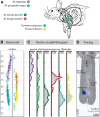Sprouting of brainstem-spinal tracts in response to unilateral motor cortex stroke in mice
- PMID: 24573294
- PMCID: PMC6795311
- DOI: 10.1523/JNEUROSCI.4384-13.2014
Sprouting of brainstem-spinal tracts in response to unilateral motor cortex stroke in mice
Abstract
After a stroke to the motor cortex, sprouting of spared contralateral corticospinal fibers into the affected hemicord is one mechanism thought to mediate functional recovery. Little is known, however, about the role of the phylogenetically old, functionally very important brainstem-spinal systems. Adult mice were subjected to a unilateral photothrombotic stroke of the right motor cortex ablating 90% of the cross-projecting corticospinal cells. Unilateral retrograde tracing from the left cervical spinal hemicord devoid of its corticospinal input revealed widespread plastic responses in different brainstem nuclei 4 weeks after stroke. Whereas some nuclei showed no change or a decrease of their spinal projections, several parts of the medullary reticular formation as well as the spinally projecting raphe nuclei increased their projections to the cortically denervated cervical hemicord by 1.2- to 1.6-fold. The terminal density of corticobulbar fibers from the intact, contralesional cortex, which itself formed a fivefold expanded connection to the ipsilateral spinal cord, increased up to 1.6-fold specifically in these plastic, caudal medullary nuclei. A second stroke, ablating the originally spared motor cortex, resulted in the reappearance of the deficits that had partially recovered after the initial right-sided stroke, suggesting dependence of recovered function on the spared cortical hemisphere and its direct corticospinal and indirect corticobulbospinal connections.
Keywords: brainstem; plasticity; recovery; sprouting; stroke; tracing.
Figures







References
-
- Bach LM, Magoun HW. The vestibular nuclei as an excitatory mechanism for the cord. J Neurophysiol. 1947;10:331–337. - PubMed
-
- Benecke R, Meyer BU, Freund HJ. Reorganisation of descending motor pathways in patients after hemispherectomy and severe hemispheric lesions demonstrated by magnetic brain stimulation. Exp Brain Res. 1991;83:419–426. - PubMed
Publication types
MeSH terms
Substances
LinkOut - more resources
Full Text Sources
Other Literature Sources
Medical
